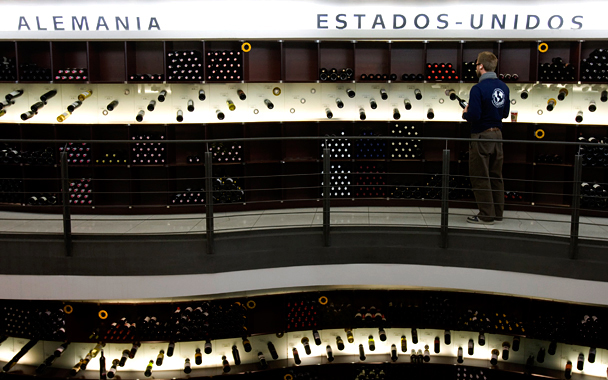I love Spanish wine and drink a lot of it, both from well-known, time-honored regions and from denominaciones that, 15 or 20 years ago, would have been all but unknown to most of the wine-drinking world (myself included). I’m always looking for new discoveries from Spain, though, so when I attended the annual Madrid Fusión gastronomic conference earlier this year and saw that there was to be a tasting called “Innovative Spain: Ancient Vineyards, New Wines,” I made sure to grab myself a seat.
Some Spanish winemakers today are upgrading and revitalizing traditional wine regions, grape varieties, and wine styles, respectfully modernizing the country’s winemaking heritage. (Though hardly its only exponent, Telmo Rodríguez is sort of the poster boy for this phenomenon; his family runs the celebrated Remelluri estate in Rioja but he himself now makes excellent wines, sometimes at real bargain prices, in about a dozen parts of Spain, some of them fairly obscure.) Other Spanish vignerons seem to be attempting to internationalize their country’s wine production. By that I mean that they are planting (mostly) French varieties—grapes that, until the latter part of the 20th century, were grown in Spain, if at all, only in small quantities in a few specific locales—and using them to concoct oaky, heavily extracted wines that seem designed to please the critics (from Robert Parker on down) rather than the ordinary oenophile.
This trend toward internationalization smacked me right in the palate at the “Innovative Spain” tasting. The wines started promisingly enough with a soft, elegant Cava, Raventós i Blanc Gran Reserva de la Finca 2004, which had a suggested retail price of 14 euros, just over $18—wonderful wine for the money. Then came a steely, aristocratic Rías Baixas, Condes de Alberei en Rama 2005, at a steep 40 euros ($52) a bottle; “ridiculous price,” I jotted down in my notes. Three wines later (after a wine from Valdeorras in Galicia and one from near Segovia in Castilla y León, both very nice and fairly priced), I found out how ridiculous Spanish wine prices could get.
The wine was Enate Uno Chardonnay 2006 from Somontano, in the region of Aragon. It was extremely rich, almost unctuous, and almost chewy with oak, thanks to barrel fermentation and 20 months in new French oak barriques; it had all the subtlety of a Harvey Wallbanger. Then I noticed the price: 300 euros—nearly $400—a bottle. Surely this was a mistake. Did they mean 30 euros? Or maybe 300 euros a case? One of the other tasters asked precisely that question of Pilar Molestina, editor of the El País wine annual, who had been rattling on endlessly about the wines from the podium. No, she replied, that was correct—though she did remark that the price was “bastante notable,” quite remarkable. I’ll say.
I’m not opposed to the cultivation of Chardonnay in Spain (that Cava I’d had earlier had some in it, and it lent the wine a charming fullness), or of any other imported grape variety, for that matter. Some Spanish winemakers use these grapes skillfully and marry them happily with indigenous varieties—and if some other Spanish winemakers want to turn their backs on tradition and produce what are in effect Australian or Argentinian wines, that’s their perogative. But the whole idea of a Chardonnay from Somontano, a region with no history of good Chardonnay—a region, frankly, with only a very short history of good wine, period—costing as much as a bottle of a legendary white Burgundy like Le Montrachet is just plain silly. No, it’s more than that: It’s an insult to many generations of fine winemakers in France and California and, yes, in Spain, who have given us good and great wines at fair prices, or who at least have earned the right to charge a lot through skill, consistency, and years of acclaim.
At Madrid Fusión a few days after I had encountered the Enate Uno, the winners were announced in a competition to honor the best Spanish wines priced under 30 euros a bottle. I happened to taste one of them a few days later at a restaurant in San Sebastian, Pazo Piñeiro de Lusco 2005, an Albariño fermented and aged in stainless steel that was sunny and fruity and full of life—a joy to drink. It cost 20 euros, one-fifteenth the price of the Enate. If you ask me, it was 15 times the wine.

